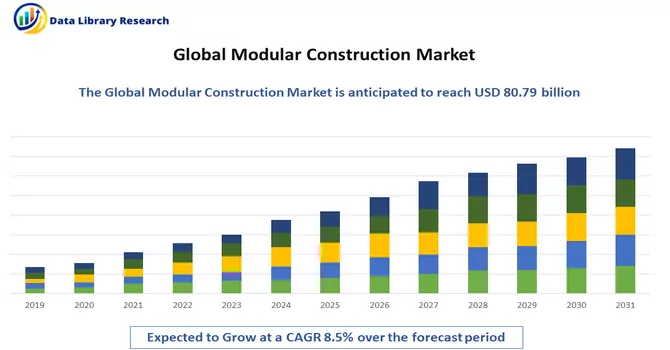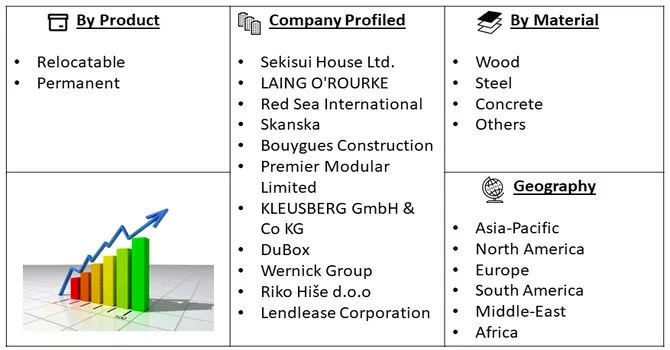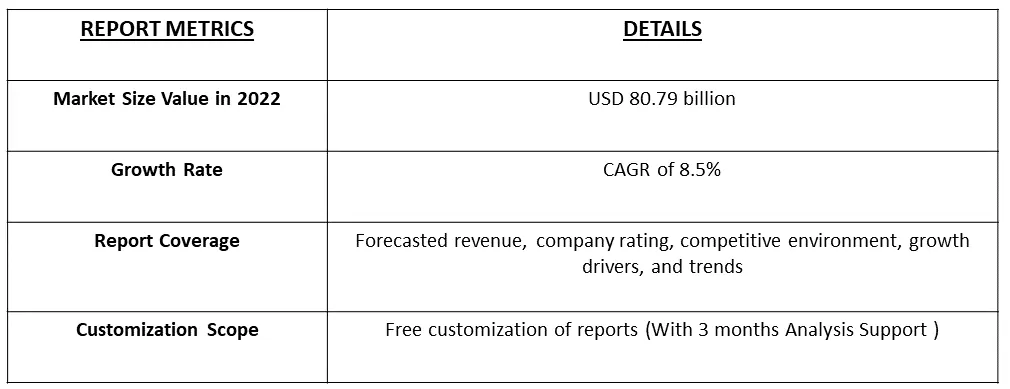The global modular construction market size was estimated at USD 80.79 billion in 2022 and is expected to register a growth of 8.5% over the forecast period, 2023-2030.

Get Complete Analysis Of The Report - Download Free Sample PDF
This growth is attributed to the growing demand for affordable housing coupled with the increasing investment in the development of healthcare and commercial infrastructure around the globe.
Off-site building activities in the urban regions are also growing, which is further driving the growth of the modular construction market. Off-site building is not affected by weather conditions as they are manufactured within closed factories using advanced machinery, thereby, optimizing the construction time and providing high-quality products. The aforementioned benefits of off-site building make modular construction cost-effective and contribute to less site-generated waste.
The global modular construction market has been experiencing significant growth and innovation in recent years. Several trends are shaping the industry, reflecting the demand for more efficient, sustainable, and cost-effective construction methods. Sustainability is a major driver in modular construction. Companies are increasingly using eco-friendly materials and adopting green building practices to reduce the environmental impact of construction projects. Modular buildings are known for their energy efficiency and reduced carbon footprint. Thus, these are the latest trends in the studied market.
Segmentation:
Modular Construction Market Size, Share & Trends Analysis Report
By Product
By Material
Geography
The market sizes and forecasts are provided in terms of value in USD billion for all the above segments.

For Detailed Market Segmentation - Download Free Sample PDF
Drivers:
Growth Of Off-Site Construction
Modular construction is significantly faster than traditional construction methods. The ability to fabricate building components offsite and simultaneously prepare the construction site leads to shorter project timelines. Modular construction often results in cost savings due to reduced labor costs, decreased material waste, and fewer weather-related delays. This cost-effectiveness is particularly attractive to budget-conscious clients. The controlled factory environment in modular construction ensures precision and consistency in building components. This leads to higher construction quality and fewer defects compared to onsite construction.
The construction industry is expected to grow worldwide due to rapid urbanization and industrialization, which will lead to an increase in the number of new projects, primarily in the commercial and industrial sectors. The growth of the construction industry is further fueled by increasing technological advancements in the building industry. Modular construction is one such technology that is gaining popularity due to its advantages such as reduced building schedule, reduced cost, greater flexibility, reuse, and less material waste, which are contributing to the product demand.
Restraints:
High Initial Investment
Setting up or retrofitting factories for modular construction can require a significant initial investment. This cost may be a barrier for smaller construction firms. Transporting modules to construction sites can be expensive, especially for projects located far from the manufacturing facility. This cost consideration affects the overall project budget. This may slow down the growth of the studied market.
The COVID-19 pandemic had a multifaceted impact on the modular reconstruction market. While initial challenges such as supply chain disruptions were evident, the pandemic also showcased the adaptability and effectiveness of modular construction in responding to urgent healthcare needs and infrastructure demands. This led to increased adoption, investment, and recognition of the value of modular methods in addressing future challenges in construction and reconstruction. The pandemic highlighted the need for affordable and rapidly deployable housing solutions. Modular construction gained increased attention in the residential sector, with the potential to address housing shortages more swiftly than traditional construction methods, thereby the market witnessed significant growth over the forecast period.
Segmental Analysis:
Based On Product, the Permanent Modular Construction Segment Dominated the Market
Permanent Modular Construction (PMC) is an innovative construction method that involves the design, fabrication, and assembly of building modules in a controlled factory environment and their subsequent installation at the construction site. PMC differs from traditional construction in that it focuses on creating permanent structures, such as commercial buildings, schools, healthcare facilities, and residential buildings, using modular components. PMC involves the offsite manufacturing of building components, or modules, in a factory. These modules are built to the same building codes and standards as conventionally constructed buildings. Thus, the region is expected to witness significant growth over the forecast period.
The Steel Segment has Emerged as the Largest Market Segment Over The Forecast Period
The use of steel in modular reconstruction provides numerous benefits, including structural strength, design flexibility, speed of construction, and sustainability. Steel components play a critical role in ensuring the structural integrity, durability, and longevity of modular buildings across various industries, from commercial and industrial facilities to residential and healthcare projects. Thus, the segment is expected to witness significant growth over forecast period.
North American region is Expected to Witness Significant growth Over the Forecast Period
The North American market is anticipated to witness growth in terms of both the number of building units and revenue. To achieve cost savings, several multinational companies are investing in advanced modular construction technologies such as Building Information Modeling (BIM), artificial intelligence (AI), Internet of Things (IoT), 3D printing, and real-time data analytics. Moreover, the U.S. government and companies are making substantial investments in the modular construction sector to provide multifamily residential structures, thereby driving market growth. Thereby the market is expected to witness.

Get Complete Analysis Of The Report - Download Free Sample PDF
Competitive Analysis:
Key players have adopted various growth strategies, such as acquisitions, mergers, contracts, and agreements, to increase their shares in the market and enhance their product and service portfolios. Additionally, they are focusing on energy efficiency and customization to fulfill specific customer requirements. Some prominent players in the global modular construction market include:
Recent Developments:
1) February 2023: Leading building materials manufacturer Everest Industries Ltd. announced that its Board has approved a capital expenditure of INR125 crore for setting up a new manufacturing facility in Andhra Pradesh. The new investment will help the company to enhance its existing capacity of 72,000 MTPA to 1,14,000 MTPA for the Steel Buildings Division. The capital expenditure is likely to be operational by March 31, 2024, and shall be funded through a mix of debt and internal accruals.
2) February 2023: EPACK PREFAB, a manufacturer of pre-engineered building solutions, is expanding its manufacturing footprint with an investment of INR 198 crore to set up a new facility spread over 25 acres in Andhra Pradesh. At present, it has two manufacturing plants in Rajasthan and Greater Noida, with a total capacity to produce 1,00,000 metric tonnes of prefabricated material annually, which will increase to 200,000 metric tonnes with the third plant.
Q1. What is the current Modular Construction Market size?
The global Modular Construction Market size was estimated at USD 80.79 billion.
Q2. What is the Growth Rate of the Modular Construction Market?
Modular Construction Market is expected to register a growth of 8.5% over the forecast period.
Q3. What are the Growth Drivers of the Modular Construction Market?
Growth Of Off-Site Constructions are the Growth Drivers of the Modular Construction Market.
Q4. Which region has the largest share of the Modular Construction Market? What are the largest region's market size and growth rate??
North America has the largest share of the market . For detailed insights on the largest region's market size and growth rate request a sample here.
Data Library Research are conducted by industry experts who offer insight on industry structure, market segmentations technology assessment and competitive landscape (CL), and penetration, as well as on emerging trends. Their analysis is based on primary interviews (~ 80%) and secondary research (~ 20%) as well as years of professional expertise in their respective industries. Adding to this, by analysing historical trends and current market positions, our analysts predict where the market will be headed for the next five years. Furthermore, the varying trends of segment & categories geographically presented are also studied and the estimated based on the primary & secondary research.
In this particular report from the supply side Data Library Research has conducted primary surveys (interviews) with the key level executives (VP, CEO’s, Marketing Director, Business Development Manager and SOFT) of the companies that active & prominent as well as the midsized organization
FIGURE 1: DLR RESEARH PROCESS

Extensive primary research was conducted to gain a deeper insight of the market and industry performance. The analysis is based on both primary and secondary research as well as years of professional expertise in the respective industries.
In addition to analysing current and historical trends, our analysts predict where the market is headed over the next five years.
It varies by segment for these categories geographically presented in the list of market tables. Speaking about this particular report we have conducted primary surveys (interviews) with the key level executives (VP, CEO’s, Marketing Director, Business Development Manager and many more) of the major players active in the market.
Secondary ResearchSecondary research was mainly used to collect and identify information useful for the extensive, technical, market-oriented, and Friend’s study of the Global Extra Neutral Alcohol. It was also used to obtain key information about major players, market classification and segmentation according to the industry trends, geographical markets, and developments related to the market and technology perspectives. For this study, analysts have gathered information from various credible sources, such as annual reports, sec filings, journals, white papers, SOFT presentations, and company web sites.
Market Size EstimationBoth, top-down and bottom-up approaches were used to estimate and validate the size of the Global market and to estimate the size of various other dependent submarkets in the overall Extra Neutral Alcohol. The key players in the market were identified through secondary research and their market contributions in the respective geographies were determined through primary and secondary research.
Forecast Model
